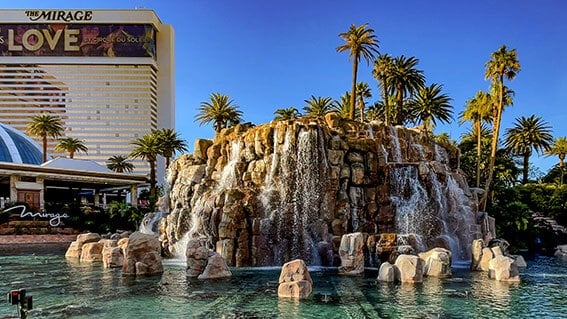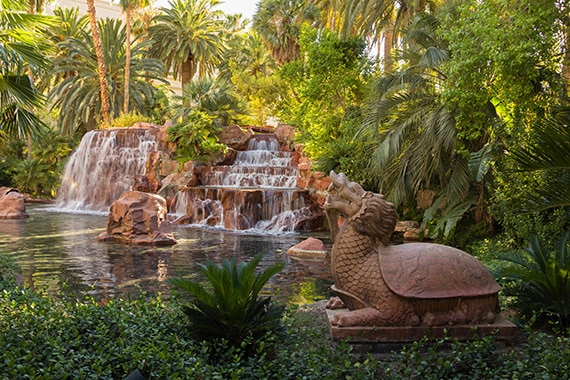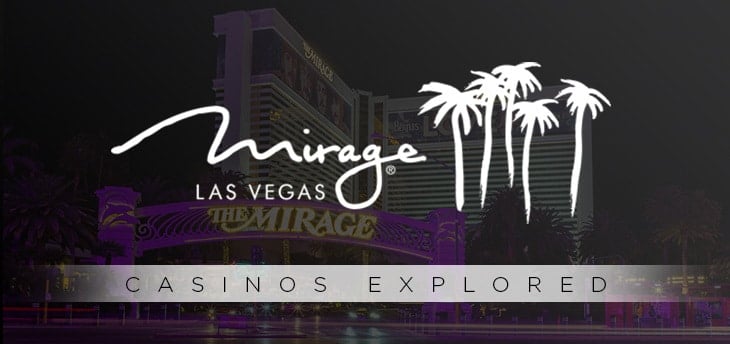There are few things in Vegas as iconic as its mega-resorts. These multi-billion dollar buildings are a city staple, giving visitors absolutely everything they could ever wish for. Luxury hotels, fine dining, and of course, world-class gambling.
Mega-resorts are a relatively recent addition to Vegas, having only appeared in the late 80s. Still, their impact on Vegas is undeniable, revolutionizing the city’s economy and helping it bounce back from the recession after the Vietnam War.
Today, we’ll look at a critical part of Vegas history: the first-ever mega-resort. We’ll explore the full history of the Mirage, from its creation as the brainchild of Steve Wynn to its modern-day transformation led by MGM Resorts.
Vegas before the Mirage
Before the Mirage was built, things looked bleak for Vegas. The first major issue was the ongoing financial crisis as a result of the Watergate Scandal and the Vietnam War. The whole US was struggling, especially Nevada.
The next factor was the explosive growth of Atlantic City. After its first-ever casino was created in 1978, the gaming industry started thriving. With $325 million worth of gaming revenue in 1979 and $1.1 billion by 1981, it looked like Atlantic City was well on its way to eclipsing Vegas as the US gambling capital.
The final problem was the ongoing dispute between the city’s employees and managers. Following a citywide strike in 1984, employee morale was at an all-time low, greatly impacting customer service.

Steve Wynn Puts Employees First
The abysmal state of Vegas before the Mirage made Steve Wynn’s decision even more revolutionary. Wynn helped establish the Golden Nugget, which was one of Atlantic City’s most famous casinos. He planned to establish a new tropical-themed resort in Vegas, eventually settling on “The Mirage” as the name to emphasize the place as an oasis in Nevada’s desert.
Wynn’s biggest priority when working on the Mirage was the employees. He told his team that the Mirage would never be about the building, but instead the employees’ commitment to excellence. Wynn negotiated a new union contract, bridging the gap between management and employees.
Wynn’s dedication to employee satisfaction was revolutionary. He treated employees like guests, giving them a high-quality staff dining room. He maintained that employee satisfaction is directly related to customer satisfaction and profitability, keeping it a focal point of the Mirage’s philosophy.
The annual turnover rate during the Mirage’s first year was 12 percent, which is incredible compared to the 50 percent turnover rate which was standard at the time. The Mirage went 10 years without a single union grievance or arbitration.

1989: The Mirage Opens
When the Mirage opened its doors on November 22, 1989, it set multiple records right from the start. It was one of the largest hotels in the world, the first hotel built in Vegas in over 15 years, and the most expensive hotel in history at a whopping $630 million in construction costs.
Guest satisfaction was the cornerstone of the Mirage’s design. Its 24 elevators and unique Y shape reduced the distance guests needed to walk to their rooms, eventually becoming an industry standard. There were even extra elevators for employees only, meaning room service didn’t need to compete with housekeeping.
The Mirage cared about each and every guest’s experience, and there was nowhere this was more apparent than the entertainment. Before, casinos would focus on the VIPs. They had special booths in the showrooms, while the general audience was left with low-quality seats. The Mirage took after Broadway theaters, giving each seat a great view of the performance.
The Mirage’s entertainment was not limited to the showroom. It featured a 90-foot volcano that attracted guests from outside to the property; this type of entryway attraction eventually became commonplace. The resort had a 53-foot aquarium, filled with over a thousand species of fish. Right past the check-in was a rainforest atrium which became one of the resort’s most iconic and photographed features.
The Mirage’s Polynesian theme was integral to its popularity, and many of the mega-resorts that followed it came with themes of their own. It had a habitat for Siegfried and Roy’s white tigers. The popularity of that exhibit later inspired a dolphin habitat, which also became a huge hit.

2000 – Present: The Mirage Switches Hands
The Mirage went through a few more developments over the years, once hosting the Cirque du Soleil show Nouvelle Expérience in 1983. Wynn’s success at the Mirage led him to work on other projects; in 1998, he opened the Bellagio, one of today’s most iconic hotels.
In 2000, MGM International acquired the Mirage. In December 2022, Hard Rock International took over the Mirage, becoming the first tribal gaming operator on the Vegas Strip. They plan on rebranding it as the Hard Rock Las Vegas, complete with a guitar-shaped hotel tower replacing the iconic volcano.
Present Day Mirage
The Mirage’s rooms are smaller than the Vegas average, but much larger than the national one. Like all MGM properties, they offer the signature “Stay Well” rooms, which are fitted with air purifiers, aromatherapy, and circadian mood lighting to give a mini-spa experience.
The Mirage casino isn’t the biggest, but it has everything you need. A diverse selection of slots and table games, a 25-table poker room, a huge sportsbook with 85-inch displays, and six screens dedicated to horse racing.

